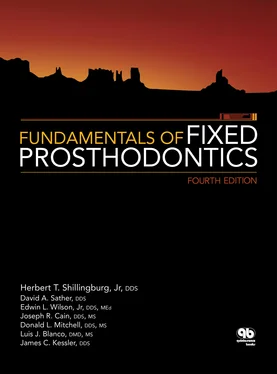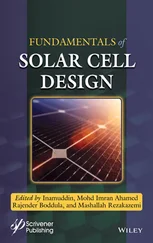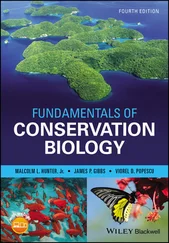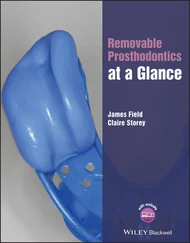| Missing: Both maxillary central incisors and one lateral incisor Abutments: Both canines and the remaining lateral incisor Considerations: If the remaining lateral incisor is questionable, it should be extracted and the fixed partial denture lengthened to include the first premolars. Inclusion of first premolars as abutments will depend on span length and curvature. Retainers: MCRs Pontics: Modified ridge lap MCRs Abutment-pontic root ratio: 1.3 |
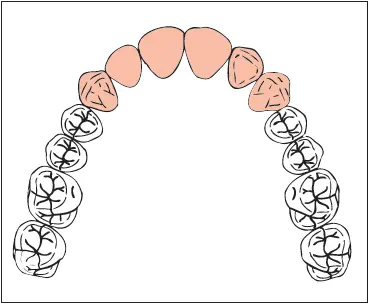 |
 |
Missing : Both maxillary central incisors and one lateral incisor Implants : 4.0 × 12 mm (central incisors), 3.5 × 12 mm (lateral incisor) Considerations : A large nasopalatine foramen (incisive canal) may interfere with implant placement. The loss of a maxillary lateral incisor frequently results in the collapse of the facial plate of bone, which can cause a facial concavity that will require implant placement too far to the lingual. This will result in an unnatural lingual contour of the crown and a poor implant emergence profile. To correct this problem, bone grafting is required to eliminate the facial concavity. Splinting the dental implant restoration will reduce rotational forces on the abutment screws, lessening the possibility of screw loosening. Splinting the dental implants will increase restoration strength and stress distribution. Restorations : MCRs over custom abutments (UCLA, Atlantis, or preparable abutments) |
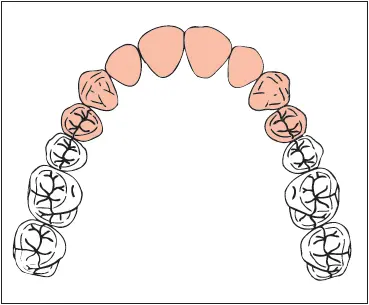 |
Missing: All maxillary incisors Abutments: Both canines and first premolars Considerations: To counteract the lever arm created by the curve of the anterior segment of the arch, double abutments are often used with full coverage retainers to assure maximum retention. If the anterior curvature is slight and/or the canines are exceptionally large, the premolars may be omitted as abutments. Retainers: MCRs Pontics: Modified ridge lap MCRs Abutment-pontic root ratio: 1.3 |
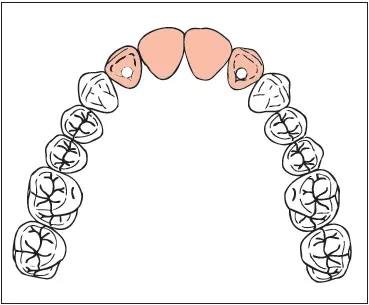 |
Missing: All maxillary incisors Implants: 4.0 × 12 mm (lateral incisors) Considerations: The loss of maxillary incisors frequently results in the collapse of the facial plate of bone, producing a facial concavity, which requires implant placement too far to the lingual. This will result in an unnatural lingual contour of the crown and a poor emergence profile. Bone grafting will be required to eliminate the facial concavity. Restorations: MCRs over custom abutments (UCLA, Atlantis, or preparable abutments) |
| Missing: All mandibular incisors Abutments: Both canines Considerations: There is no need to use double abutments on the mandibular canine-to-canine fixed partial denture because the forces are less destructive. If a patient has a lone lateral or central incisor remaining, it is usually extracted. It would complicate the fixed partial denture without adding any appreciable support. Retainers: MCRs Pontics: Modified ridge lap MCRs Abutment-pontic root ratio: 0.8 |
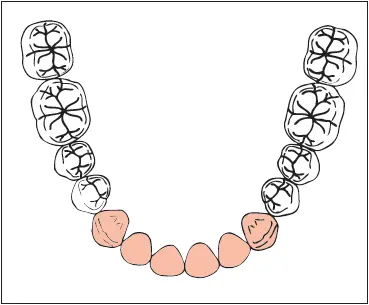 |
| Missing: All mandibular incisors Implants: 4.0 × 12 mm (lateral incisors) Considerations: Increased available space allows for the use of the larger 4.0-mm-diameter implants when replacing all four mandibular incisors. Restorations: MCRs over custom abutments (UCLA, Atlantis, or preparable abutments) |
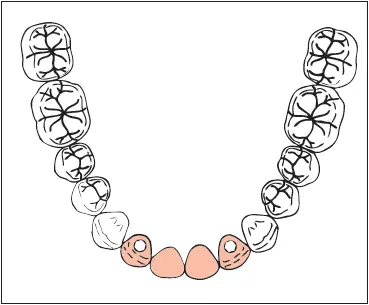 |
| Missing: Maxillary first and second premolars and first molar Abutments: Canine and second molar Considerations: This fixed partial denture can be made only if the clinical crowns of the abutments are long and perfectly aligned. The occlusogingival dimension of the edentulous space must be ample to provide adequate rigidity. This fixed partial denture is possible only if the opposing occlusion is a removable partial denture. Canine guidance is important in this situation. Retainers: MCR on the canine and FGC on the molar Pontics: MCRs Abutment-pontic root ratio: 0.8 |
 |
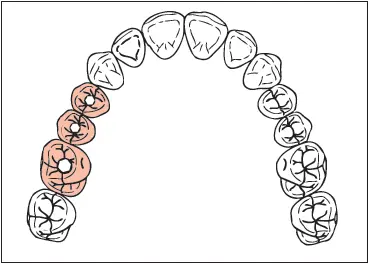 |
Missing: Maxillary first and second premolars and first molar Implants: 4.0 × 13 mm (first premolar), 4.3 × 11.5 mm (second premolar), 5.0 × 11.5 mm (first molar) Considerations: Three implants are preferable, but not if it requires placing them too close together. The maxillary sinus will likely interfere with the placement of an implant of desirable length, necessitating sinus modification surgery such as a sinus graft or a vertical upfracture. Splinting the dental implant restoration will reduce rotational forces on the abutment screws, lessening the possibility of screw loosening. Splinting the dental implants will increase restoration strength and stress distribution. Restorations: MCRs over custom abutments (UCLA, Atlantis, or preparable abutments) |
 |
Missing: Mandibular first and second premolars and first molar Considerations: A fixed partial denture should not be used in this situation because the interarch space is usually insufficient and occlusal force will be directed against the inner curvature of the occlusal plane, with resultant lifting forces on the retainers. Missing: Mandibular first and second premolars and first molar Implants: 4.3 × 11.5 mm (first premolar), 4.3 × 10 mm (second premolar), 5.0 × 10 mm (first molar) Considerations: Three implants are preferable, but not if it requires placing them too close together. The position of the anterior loop of the mandibular canal may interfere with implant placement. Loss of the facial plate of bone may result in inadequate alveolar width. Alveolar resorption may lead to insufficient height of bone above the mental foramen and mandibular canal. The correction of this anatomical difficulty requires the placement of an onlay bone graft to allow the placement of an implant of sufficient width and length. Splinting the dental implant restoration will reduce rotational forces on the abutment screws, lessening the possibility of screw loosening. Splinting the dental implants will increase restoration strength and stress distribution. Restorations: MCRs over custom abutments (UCLA, Atlantis, or preparable abutments) |
